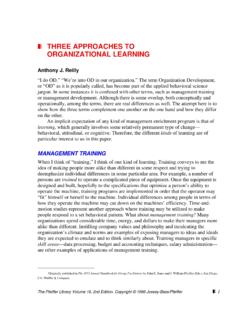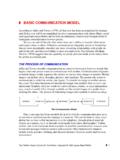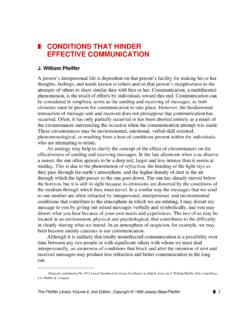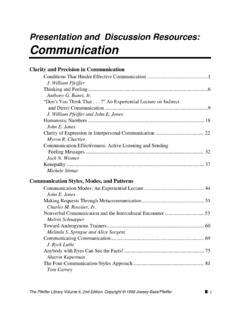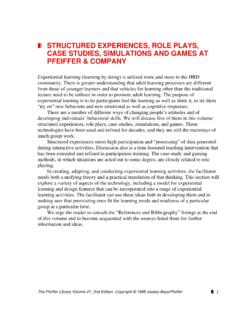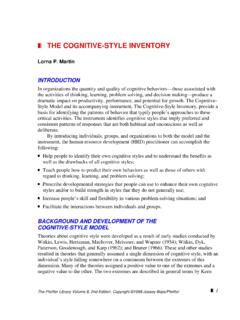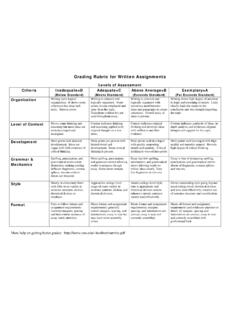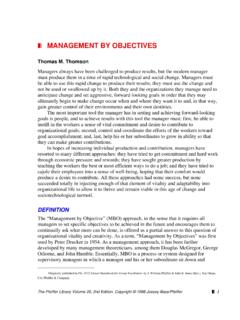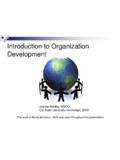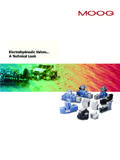Transcription of General Introduction to the Pfeiffer Library
1 Main MenuIntroductionCreditsHelpAbout Jossey-Bass/PfeifferSince 1968, Jossey-Bass/ Pfeiffer (formerly University Associates, Inc., and now an imprintof Jossey-Bass Inc., Publishers) has been committed to publishing in the broad field ofhuman resource development (HRD). The organization has earned an international reputa-tion as a leading source of practical publications that are immediately useful to today sfacilitators, trainers, consultants, and managers. These materials are designed for the HRDpractitioner who wants access to a broad range of training and intervention technologies aswell as background in the Years of ExpertiseThe Pfeiffer Library celebrates years of expertise with a compilation of bestselling Jossey-Bass/ Pfeiffer products, including materials from the following sources.
2 1972 1997 Annuals Volumes I X of the Handbooks of Structured Experiences University Associates Training Technologies Theories and Models in Applied Behavioral ScienceThese materials have been reedited and reorganized to form one comprehensiveresource, categorized according to the following topics (the design of the entire Library isrepresented graphically on the grid found in the Main Menu): General Introduction to the Pfeiffer LibraryCustomize in WordMain MenuIntroductionCreditsHelp Individual Development: Materials on personal awareness, growth, change, risk taking,sex roles, diversity, stress, and life/career planning. Communication: Materials on communication styles and approaches, coaching, con-frontation, feedback , and negotiation.
3 Problem Solving: Materials that focus on techniques for generating alternatives, sharinginformation, understanding conflict, reaching consensus/synergy, and action planning. Groups: Materials about how groups work, competition/collaboration, conflict, andnegotiating/bargaining. Teams: Materials that relate to team-building and team-development issues and concerns. Consulting: Materials that address organization development (OD) theory and practiceand interface with clients. Facilitating: Materials relating to skills of the facilitator, from needs assessment throughclosing. Leadership: Materials involving leadership styles, ethics, interviewing/appraisal, motiva-tion, and diversity/stereotyping.
4 Training Technologies: Materials that offer background and techniques for using experi-ential learning activities; inventories, questionnaires, and surveys; and presentation anddiscussion resources. Theories and Models in Applied Behavioral Science: Descriptions of theories andmodels that apply to individuals, groups, management, and organizations. Keyword Index: Index to the Library , with keywords organized alphabetically and linkedby Pfeiffer Library can be used in a variety of ways. It can be studied for its collectedinformation on HRD. Trainers and consultants can use it for design ideas for workshops,Customize in WordMain MenuIntroductionCreditsHelpseminars, and OD or HRD interventions.
5 All types of materials related in subject matter canbe easily identified and selected. For example, by consulting the grid that begins this program,a trainer who wants activities, instruments, and handouts on the topic of communicationwould learn to check the three volumes of the Pfeiffer Library that deal with pieces can be located in the index, either by title or by author. In addition, thekeyword index makes it possible to locate activities, instruments, and articles that addressspecific of the Pfeiffer LibraryExperiential Learning ActivitiesExperiential learning activities are infinitely varied and variable. Activities should be selectedbased on the participants needs and the facilitator s competence.
6 Within a particular cat-egory, many activities might accomplish similar goals and be adapted to suit the particularneeds of a group. However, for the activity to address the needs of the participants, thefacilitator must be able to assist the participants in successfully processing the data thatemerge from that you have seen on the grid, within the Pfeiffer Library , the following volumes andtopics apply to experiential learning and Technologies for Experiential Learning ActivitiesCustomize in WordMain MenuIntroductionCreditsHelpInventories, Questionnaires, and SurveysInstrumented survey- feedback tools give the participants opportunities to develop an under-standing of the theories involved in the dynamics of their own group situations understand-ing that will increase their involvement.
7 Instruments allow the facilitator of a small group tofocus the energies and time of the participants on the most appropriate material and also todirect, to some extent, the matters that are dealt with in a session. In this way, the facilitatorcan ensure that the issues worked on are crucial, existing ones rather than less important onesthat the members may introduce to avoid grappling with the more uncomfortable the Pfeiffer Library , the following volumes and topics apply to inventories,questionnaires, and and and Training Technologies for Inventories, Questionnaires, and SurveysPresentation and Discussion ResourcesLearning based on direct experience is not the only kind of learning appropriate to human-interaction training.
8 A practical combination of theory and research with experiential learn-ing generally enriches training and may be essential in many types of cognitive and skilldevelopment. Affective and cognitive data support, alter, validate, extend, and complementeach other. Each facilitator needs to develop a repertoire of theory and background that heor she can use in a variety of in WordMain MenuIntroductionCreditsHelpWithin the Pfeiffer Library , the following volumes and topics apply to presentation anddiscussion and Leadership23. Training Technologies for Presentation and Discussion ResourcesTheories and ModelsA theory is an explanation of causal relationships; a model, on the other hand, refersprimarily to a graphic representation of a system or process and the relationships among itselements.
9 Presenting theories and models in a training session provides a frame of referencefor an experience that gives it meaning and connects it with other the Pfeiffer Library , the following volumes describe theories and models inapplied behavioral science:24. in WordMain MenuIntroductionCreditsHelpConclusionCha nge remains an unchanging feature in modern life, and the rate of change continues toaccelerate faster than the human capacity for accepting and integrating it. Experientiallearning addresses how adults learn and change best through active involvement. Researchstudies estimate that adults remember 10 percent of what they hear and 25 percent of whatthey see. However, they remember 90 percent of what they do.
10 Seeing and hearing createthe potential for new behavior, but new behavior comes about only by taking action. Expe-riential learning consists of doing something, looking back at it critically, gaining insights,and putting the results to Pfeiffer Library represents the single most comprehensive set of experientiallybased resource materials available to human resource facilitators, trainers, and consultants. Itexemplifies a commitment to experiential learning and to providing a stimulating source ofideas and a wealth of practical and varied materials. As the preface to the 1974 AnnualHandbook for Group Facilitators noted, In addition to our abiding belief in the wide distri-bution of human relations training materials, we also experience a constant undercurrent ofexcitement and challenge as we create, collect, collate, use, and disseminate this emergingtechnology.
